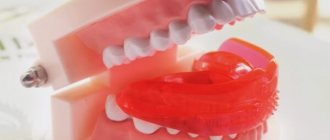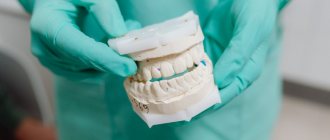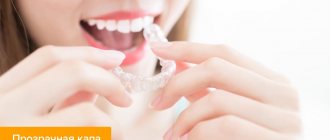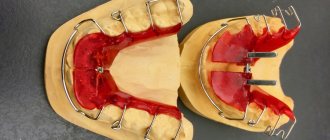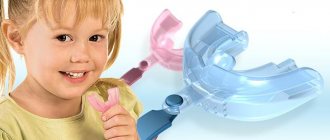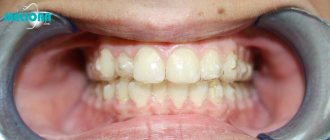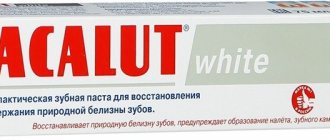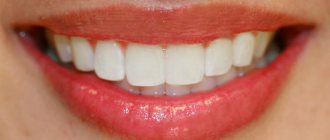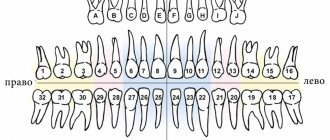Dental trainers are a type of myofunctional correctors that are used to correct bites along with classic plates and brace systems that are already familiar to everyone. The main feature of trainers is that they not only remove the consequences - they correct incorrectly formed teeth, but work with the cause: they help develop the jaw muscles, remove excess pressure on the bones, form correct nasal breathing, and tongue position. That is why this method of treatment is considered more promising.
Indications for the use of dental trainers
A dental trainer is usually prescribed to be worn in the following situations:
- a person cannot have braces installed for one reason or another;
- the bite has formed incorrectly;
- swallowing is impaired;
- teeth are displaced;
- often stuffy nose due to problems in the oral cavity;
- complexes or profession do not allow wearing other systems;
- there are speech therapy problems, etc.
Sometimes, if a doctor sees that a patient is at risk of malocclusion, he will prescribe a dental trainer as a preventive measure.
Read in detail about problems with bite here: All about bite: what it is like
Who should not wear trainers?
The systems described are primarily medical devices, so if you are impressed by the various photos before and after the trainer and want to buy such a device for yourself, be sure to consult with your doctor. Self-treatment with a trainer is dangerous and can cause harm.
There are other situations when it is better to choose another treatment option:
- if there is nasal congestion, which has become chronic (the patient simply will not be able to train at full strength, because he will have breathing problems);
- when the bite of the teeth in the lateral areas is cross;
- if a trainer is chosen for a child , but the child is uncontrollable and does not obey his parents (classes must be on schedule, otherwise there will be no effect).
In the described cases, it is better to use braces to correct a malocclusion.
Pros and cons of treatment with trainers
Why are dental trainers for adults and children so popular? This system has many advantages that make it popular and convenient. The main advantages of treatment using such structures:
- low price. The most budget trainer is very cheap, and modern improved models still cost 3-4 times less than an inexpensive brace system;
- ease of care. The patient does not require any special cleaning products or devices - just toothpaste and a brush are enough;
- versatility. The trainer does not need to be made specifically taking into account the patient’s characteristics; you just need to choose a model by size;
- wearing does not have a negative effect on the enamel or soft tissues, the devices do not injure the tongue or gums;
- In addition to bite, trainers also solve other problems, for example, correcting speech (in cases where diction problems were caused by incorrect dentition);
- the patient experiences minimal discomfort while wearing.
An additional advantage of trainer systems is that they do not cause any psychological discomfort: the trainer can be removed at any time to eat, drink or go to an important meeting. However, this method of changing the bite also has its disadvantages:
- slow effect. You need to wear the trainer for at least a year to see real results;
- prohibition on eating and drinking while wearing. If you take a trainer for a child , this can become a serious problem;
- Treatment must be carried out strictly according to schedule and for the required amount of time per day, otherwise there will be no effect. This option is only suitable for responsible people, and children should be supervised by parents.
Trainer effect: before and after
Advantages and disadvantages of the method
Like any orthodontic method, installing trainers is not suitable for everyone; this device has its pros and cons .
- Children's devices are made in color to add emotions to the process of wearing them, while adults can undergo treatment without unnecessary attention to their smile, since the trainers of this line are most often colorless.
- The method does not cause much trouble to use, since the structures are often worn at night, and during the day they can be worn for only an hour and this will be enough for the process of straightening the teeth and easing muscle pressure.
- When using trainers, a person may not feel anything, since they do not create a feeling of discomfort.
- These devices are accessible to many; their price is an order of magnitude lower than the cost of braces or plates.
You can find out the prices for trainers for straightening teeth in adults in the following article.
In a separate publication we will talk about how to correct crooked teeth without braces.
Follow the link https://orto-info.ru/sistemyi-vyiravnivaniya-zubov/lechebno-profilakticheskie-apparatyi/treyner-t4a.html you will find reviews of the T4A trainer for adults.
Types of dental trainers
Modern trainers for teeth straightening are classified according to different criteria. There are soft models, products of medium and high hardness. Each type is created for its own case. For example, an initial trainer is a soft structure that is used for treatment in the first stages, and a retainer is a model that allows you to consolidate the results of previous treatment. Let's look at the most popular types of trainers for dentition correction.
Pre-orthodontic children's trainers
Dental trainers for children are called pre-orthodontic and are used on the primary dentition. They are divided by age: for small children it is recommended to buy the Infant model (4-6 years old), for children from 6 to 10 years old there is already a more adult model - T4K, which takes into account the change of milk teeth to permanent ones.
Trainer Infant
A children's trainer is sometimes used even if there is no malocclusion. It is prescribed in the following cases:
- mouth breathing;
- increased tone of the temporomandibular joint;
- bad habits that negatively affect the dentition (for example, thumb sucking in your sleep);
- asymmetrical teething, etc.
The first trainer - the initial one - is made of soft silicone, which adapts to the child’s oral cavity. It is left overnight and used for 8-9 months. The second trainer – therapeutic – has a rigid frame and is installed for a year or more. Sometimes a child has to wear the system until he is two years old.
There are also special children's dental trainers that help avoid malocclusion in the event of early loss of primary incisors, canines, and molars. They are prescribed from the age of 3 years for the entire period while permanent teeth are being cut.
Finish Trainers
A final orthodontic dental trainer or retainer is usually prescribed for adolescents between 10 and 13 years of age. It is used for several purposes:
- consolidate the result after treatment with braces or other methods;
- allow weakened enamel to recover faster by protecting it from bad habits;
- form correct swallowing, reduce increased tone of the facial muscles.
Doctors often use a finishing type trainer to correct the not entirely correct position of teeth after unprofessional installation of a brace system.
Finish Trainers
Joint trainers
A joint trainer or joint splint is a device that reduces or eliminates pain due to dysfunction of the temporomandibular joint (TMJ) and relaxes tense muscles of the face and neck. At the same time, it also protects your teeth if you or your child have a habit of grinding them in their sleep.
Thanks to its arc shape, the articular trainer corrects the position of the lower jaw, and the soft material allows the device to easily adapt to any characteristics of the patient.
Joint trainer
Trainers for braces
A trainer for braces is a special type of medical device. It allows you to combine the stages of instrumental and functional treatment, increasing the effectiveness of both approaches. As a result, the result of treatment with braces becomes more stable, and the process itself goes faster.
Benefits of wearing a braces trainer :
- helps relieve muscle pressure;
- protects the oral cavity from damage from braces during the night;
- eliminates bad habits, which reduces the risk of re-developing dental problems.
Examples of such devices can be viewed in our catalog: Trainers for braces
Trainer for braces
Trainers for adults
Trainers for adults are used less frequently, but are also quite popular. The structure of the models is very similar to teenage ones, but a little more complicated. A standard hard trainer for an adult consists of the following elements:
- lip bumper, which reduces the tone of the facial muscles;
- a central stop that sets the correct position of the tongue;
- enlarged lateral edges, due to which the temporomandibular joint is supported.
Products are also divided by hardness: at night a soft model is used, and during the day it is recommended to train with a hard one.
An additional advantage of trainers for adults is that they successfully combat snoring.
Trainer for adults
Terms of use
These teeth straightening systems do not require special complex care.
With their constant use, you need to follow only a few rules :
- Trainers should be cleaned with a toothbrush from time to time.
- This design comes with a plastic container in which it is recommended to store trainers.
- Closely monitor the condition of the trainers. If the patient finds any damage or a crack, he should immediately contact his doctor.
- You should pay attention to the way trainers are used; they need to be handled very carefully. You cannot bite them or try to move them in your mouth with your tongue. If the device is already in the oral cavity, try not to talk during the treatment period.
- After each treatment session, the device must be thoroughly rinsed under running tap water.
We will tell you who is recommended to buy Myobrace trainers in a new review.
In this material we will discuss how you can straighten your teeth without braces and compare the proposed methods.
Here https://orto-info.ru/sistemyi-vyiravnivaniya-zubov/lechebno-profilakticheskie-apparatyi/treyner-t4k.html we provide recommendations for using the T4K children's teeth trainer.
How to choose the right trainer?
We already know that trainers are divided into several types. How to choose them in order to eliminate abnormalities in tooth growth and bite as much as possible?
There is a division of types of trainers, depending on the age of the patient:
- T4K device is used for children 6-12 years old.
- T4A trainer is used between the ages of 12 and 15, and is sometimes used by adults.
- i-3 design is suitable for children aged 5-8 years.
- infant trainer is placed before teeth change to correct chewing, swallowing, and breathing.
- Trainers T4B, T4CII and others are installed in patients with braces to reduce treatment time and maximize the effectiveness of alignment.
What special models of trainers exist, look at the video:
How does the treatment process work?
First, the blue trainer (initial) prepares the teeth for treatment.
During this period, the force of pressure on them by the maxillofacial muscles changes, which allows the teeth to move relatively freely under the influence of the structure.
After 6-8 months of using trainers at night, the patient should change the blue trainer to a pink (final) trainer.
This type of device is much denser than the previous one, therefore it acts on the jaw according to the principle of an orthodontic arch. The teeth gradually fall into place, the bite changes.
Efficiency
If the bite is incorrect, it will take more than a year to align (including the use of initial and final trainers). Often adults who also want to improve the aesthetics of their smile use this method rather than braces.
For this purpose, T4A is used, which adapts well to the shape of the dental arch. If adults use trainers to correct crowded teeth, up to 1.5 years of treatment may be required .
The same period is needed when correcting deep bites in adults.
Doctors note that if these devices are used in childhood, the effectiveness of treatment without relapse is almost 90%.
Much depends on consistency and diligence in treatment. It is important not to skip or reduce the time you wear the trainer.
Why trainers are better than other orthodontic devices
Compared to other orthodontic devices, teeth straightening trainers benefit in three ways:
- They do not need to be worn constantly like braces. Therefore, you don’t have to limit yourself in communication or refuse to work with people. At school, children will not suffer from ridicule from classmates;
- they do not put pressure on the teeth. Braces and plates affect the teeth, destroying the enamel and injuring, irritating the mucous membrane;
- they are much cheaper and do not require individual production. The patient can buy a trainer in a store (for example, choose it from the catalog on our website) and immediately start wearing it.
Another plus is that you don’t have to wait for the trainer to be made. All you need to do is ask your doctor which model and size you need, and order it in the store. This is also different from braces, the installation of which takes a lot of time.
Trainers for correcting crooked teeth - a convenient and effective method of bite correction
Modern orthodontics has many different hardware techniques for correcting bites. One of these is a method of correcting defects using dental trainers - these are removable structures made of soft silicone, visually reminiscent of mouthguards for athletes. Unlike braces, they do not force you to change your diet and go through a difficult adaptation period. It is enough to wear such devices for several hours during the day and put them on at night. For more information about whether trainers straighten teeth, how long they should be worn, and which type to choose in your particular case, read further in this material.
How to put on and wear a trainer correctly. How long does it take to get used to
Adult and children's dental trainers are put on and worn the same way. Installing the device is quite simple:
- Place the device in your mouth so that the central stop is directed towards the upper palate. Next, find a position so that the stopper rests on the tip of the tongue and does not create discomfort.
- Move your lower jaw in different directions until the plates fit on the molars. Have you stopped slipping? You have achieved the desired result.
- Close your jaws with little force. You should feel pressure on all your teeth. You can touch the tip of the trainer with your tongue to feel if it fits correctly.
- Check if the trainer is positioned correctly: tighten your lips and take 3-4 deep breaths. If breathing is difficult, repeat the previous steps until it becomes easier.
Scheme for putting on the trainer
You need to wear the trainer for 1-4 hours during the day, as well as throughout the night. The regimen is determined by the doctor and must be followed. You can hold it for 30-40 minutes, but you cannot use the device less than necessary. If you need to remove the trainer, try to return it to its place as quickly as possible.
While wearing it, a person should not talk, eat or drink. If you are going to wear a trainer with your child, it is better to come up with entertainment for him during classes, for example, you can watch a cartoon or a movie, or draw. The habit of wearing a trainer develops over different periods of time – it all depends on the patient. At night, it is better to monitor the device regularly for at least a month (it may crash). During the day, the discomfort disappears in about a week, sometimes less.
Do not forget that while wearing a trainer, it is important to see a doctor once every two to three months. A visit to the orthodontist is a necessary procedure, because it allows you to determine the dynamics of changes in the dentition and correct the process in time if something goes wrong.
Myobrace trainers for adults
Myobrace devices are made of soft silicone, while the design itself is quite rigid, which provides the necessary pressure on the teeth. The action of such devices is aimed primarily at correcting problems such as violations of the position of the tongue or lips, and mouth breathing. Very often these habits lead to crowded teeth and other malocclusions.
The Myobrace for Adults system is available in three types - each trainer is designed for a specific stage of treatment:
- model A1: used at the very beginning. This is the softest trainer of all three models. Its main purpose is to prepare for the main treatment, namely, the elimination of myofunctional habits,
- model A2: this type of trainer is intended for more severe orthodontic disorders. It is created from hard plastic, which allows for a more targeted effect on the front teeth,
- model A3: also a rigid trainer, which is used in the final, retention period.
Indications for use and benefits
Indications
- crowding of front teeth,
- mild to moderate malocclusions,
- incorrect position of the tongue - its excessive pressure on the front teeth,
- mouth breathing,
- relapse after wearing braces,
- pressure on the teeth from the lips,
- retention period – to consolidate the results of the main treatment.
Advantages
- increased comfort, since the trainers are made of soft silicone,
- effective relief from myofunctional disorders: mouth breathing, muscle strain, incorrect tongue position,
- the trainer is invisible - you need to wear it mainly at night,
- trouble-free eating and oral care, since the structure is removable.
How to care for trainers
Caring for jaw trainers is very simple and does not require special skills. It is available to patients of all ages. Follow simple rules:
- Always rinse the device after removing it from your mouth. Whenever it gets dirty, clean the trainer with a toothbrush and toothpaste, just as you would brush your teeth.
- Store the product in a special container to prevent dust, dirt and accidental damage.
- Do not chew, chew, or boil the apparatus. You need to rinse it with warm water, not cold or hot, otherwise you can ruin the plastic.
- If the trainer is damaged, you should immediately take it to the orthodontist so that the doctor can tell you whether you can continue to use the product or whether you need to buy a new one.
conclusions
Trainers for teeth straightening are a modern and relatively painless way to combat dental anomalies and bite problems. The orthodontist prescribes wearing the device if there are certain indications, for example, swallowing is impaired, teeth are displaced, and it is not possible to install braces. Contraindications for installing trainers include chronic nasal breathing problems and crossbite.
Trainers have many advantages: most often the choice in their favor is made due to the low price and safety of the system, since it does not affect the enamel and does not irritate the mucous membranes. But there are also disadvantages, the most negative is the slow effect on the dentition. But the effect will still be there. True, you need to choose the right product among all varieties.
The trainer is easy to get used to and easy to care for. But at the same time, wearing it gives much more than conventional braces: the device eliminates the cause of malocclusion and reduces the risk of similar problems occurring in the future. This is why many orthodontists prescribe wearing trainer systems, both separately and together with the installation of braces.
In what cases are they prescribed and what are the contraindications?
It is possible to identify a number of specific phenomena and conditions for which treatment using trainers is prescribed. Here are the main indications:
- impossibility of installing a bracket system for any reason,
- deviations in the process of growth and formation of the lower jaw,
- slight crooked teeth, crowding,
- bad habits that lead to deformation of the dentofacial apparatus, for example, mouth breathing or thumb sucking during sleep,
- incorrect position of the tongue, disturbances in its functioning,
- mild malocclusion,
- excessive pressure from soft tissues on the dentition,
- retention period after the main treatment.
It is possible to use trainers after treatment with braces.
But this technique may not be applicable in all cases. For example, if there are serious problems associated with nasal breathing, or a pathological lateral bite is diagnosed. Trainers are not prescribed to patients with mental disorders when the person is not able to independently control the course of treatment. As mentioned above, such corrective mouthguards will not help correct complex anomalies, so the advisability of their use in each individual case is best left to the discretion of a specialist.
